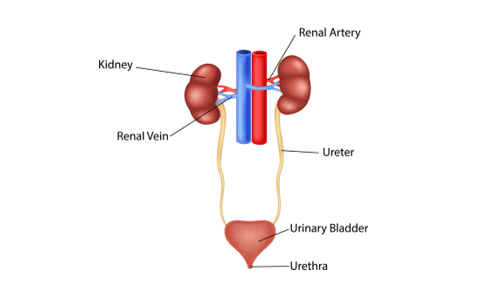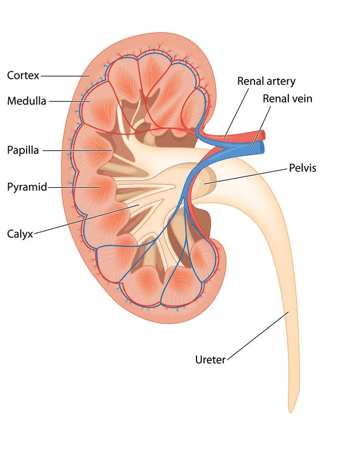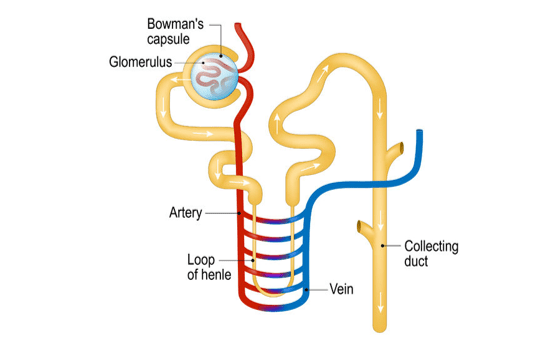In this post
Just like plants and other animals, humans must excrete waste in order to stay alive. The organs that control this include the skin, lungs and kidneys. Each of these organs has a job to do in filtering out what is not required. Substances like water and salt need to be kept at constant temperatures in the body so that chemical processes can be undertaken. Other substances include the levels of carbon dioxide in the blood, pH levels and body temperature.
Urine
One way that the body processes out waste products is through urine. An adult produces around 1.5 litres of urine every day which contains about 40 grams of waste products. These waste products include urea, ammonia, potassium, sodium chloride (salt) and others. Both urea and ammonia are nitrogenous waste which means they consist of nitrogen. All animals produce excess nitrogen in the same way which has to be excreted out of the body. These products are formed when amino acids (proteins) are broken down to be used in the body. The liver breaks down these amino acids and converts them to a carbohydrate and urea. The kidneys then filter this out in urine. It is therefore the kidney that has a huge job to do in controlling the water and salt concentrations in your body as well as excreting nitrogenous waste.

The urinary system
Each of your kidneys is supplied with blood through something called the renal artery. This blood comes straight from the body’s main artery (the aorta) so it is highly pressurised. Inside each kidney this blood is filtered and passes out through the renal vein. The urine, which is the waste from the blood, passes out of the kidney down one of two ureters and is stored in the bladder ready to be excreted. The bladder has an opening called the sphincter which is a muscle that can be contracted – we can therefore hold back the urine and control our bladder function.
The kidneys
Within a kidney there are several areas, as you can see in the diagram shown. The outer region is the cortex which contains tiny little blood vessels that go to the renal artery. It also contains ‘filtering units’ which are small tubules, also known as nephrons. These nephrons run down through the middle part of the kidney which is called the medulla. This area has bulges called pyramids that point towards the centre of the kidney. In the centre these pyramids meet up where they release urine into the area called the pelvis which connects to the ureter and then to the bladder.

When assessing the kidneys closely, scientists realised that there are around a million nephrons in each kidney. At the start of each is a small hollow cup of cells called the Bowman’s capsule. This surrounds a ball of blood capillaries called a glomerulus. It is in this area that the blood is actually filtered to remove impurities. Blood enters through the renal artery and is then divided off into smaller arteries called arterioles that supply blood to the glomerulus.

A blood vessel with a smaller diameter then carries the blood away from the glomerulus and towards a network of capillaries that surround the nephron. The pressure of the blood is very high here and this forces fluid from the blood through the walls of the capillaries and the Bowman’s capsule into the middle of the capsule. Between these areas is a layer that acts as a filter for the blood called the basement membrane. To do this the membrane holds back larger molecules but let’s through water, ions and other small molecules. The fluid that enters this capsule space is called the glomerular filtrate and this process, where different sized molecules are separated with pressure, is known as ultrafiltration.
The kidneys produce approximately 125ml of glomerular filtrate each minute which works out at around 180 litres every day. Of course, we only produce 1.5 litres of urine so only around 1% of what is filtered through the capsule leaves the body. The rest of this is reabsorbed back into the blood. We know that this is the case because scientists have analysed samples of fluid from the space in the middle of the nephron. Inside the nephron and surrounding vessels are two coiled regions separated by a U-shaped loop. This loop is called the loop of Henlé and runs down into the medulla of the kidney. After the second coiled tubule, several nephrons join up to form the collecting duct where the final urine passes out into the pelvis.

A basic way of being able to investigate what is reabsorbed in the loop of Henlé is to look at the concentrations that are present in different regions. At the beginning of the loop of Henlé the flow rate can be classed as 100%. This means that lots of water is entering the loop with proteins, glucose, urea and sodium dissolved in this. If the flow rate was to half (to 50%) then it is because half of the water has been reabsorbed back into the blood. If this happens and the concentration of chemicals is still the same then we know that an equal proportion of the glucose, urea, etc. have also been reabsorbed. Should the concentration increase, we know that the kidney has taken back some water but not reabsorbed the chemicals that are dissolved in it.
At the point before the glomerulus, the rate is classed as being 100% with protein and chemicals dissolved in the liquid. This is our start point before the filtering has started. Immediately after the glomerulus and Bowman’s capsule we have the same amount of flow, glucose, urea and sodium but no protein. This is because protein molecules are very large and are filtered out in the capsule. After the loop of Henlé, the concentration of urea increases by around a factor of 60. As well as this, the concentration of salt doubles. However, the glucose found vanishes and the flow rate drops to 1%. This means that the glucose and 99% of water have been reabsorbed back into the blood as these are useful tools. Because of the reduction in water, the concentration of urea and sodium (salt) increase. This is not due to an increase in these two substances – it is simply an increase in concentration due to a decrease in water.
Controlling the body’s water content
The kidneys not only produce urine, they also control the concentration of this urine. This means that they regulate the water content of the blood. So if you drank a large amount of water, your kidney recognises this and produces a larger amount of diluted urine. If you are dehydrated, the opposite would work and your urine would be more concentrated. The change in the amount of water present in urine is controlled by a hormone called anti-diuretic hormone, known as ADH for short.



